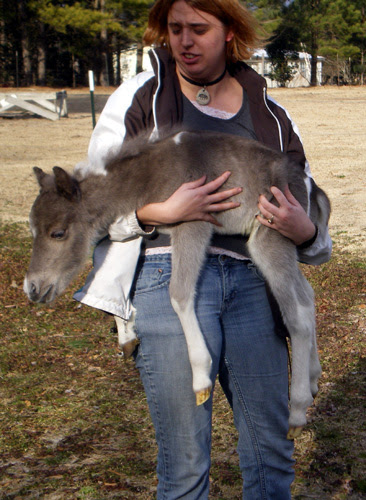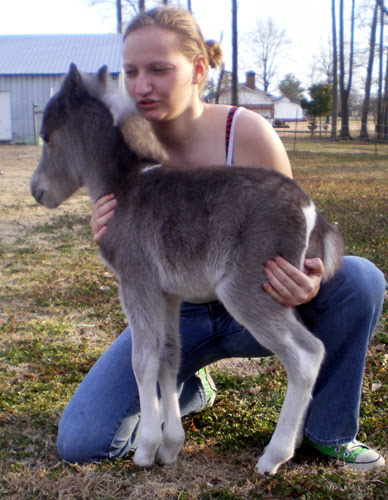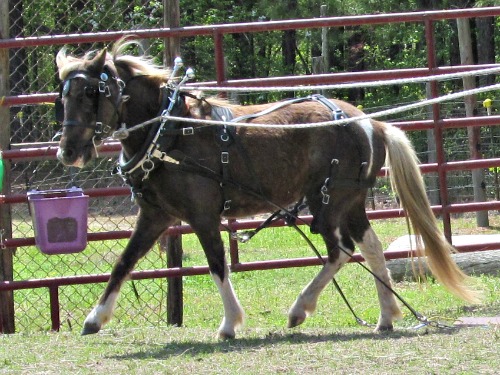The picture of her with your hubby is sweet! Cant' see the one of her running...
On fly masks - if you have found one that will fit her and you "need" to use it - put it on her. She'll get used to it or she won't. Some never do - and will do anything in their power to rub or tear it off. That can create a problem. Others - love them from day one and will soon learn to come up and stand quietly for you to put them on!
here is a pic of one of our ponies - she laid down in a newly bushhogged field and punctured her left eye at 2 weeks of age (she's a little larger than a small mini - she's 1/2 arab 1/2 hackney and matured at 13.1 hh at the withers). We did field surgery thru our vet clinic on her eye (didn't have to send her to a vet surgical unit) - 3 different times as even though she had the mask on she kept managing to rip out the stitches about 3 days after the stitching was done each time. It did heal - with the help of the flymask and the ointments. The vet finally ended up stitching the eye completely shut to aid in healing. She is now 12 years old and has produced 4 1/2 shetland foals for us... She sees fine! Rides huntseat, dressage, jumps up to 3'6", western and trail rides. I'm getting ready to continue her harness training and see if we can get her hitched...
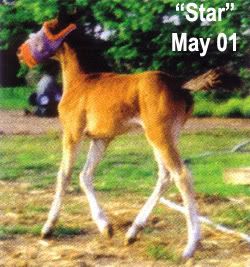
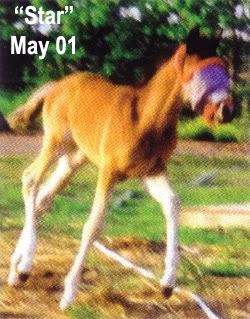
And I'm very into "natural" and allowing a mare and foal to bond - but if this filly hadn't been introduced to a halter and leading the first couple of days after she was born - doing the surgery itself and the subsequent handling for treatments - might have had to be done by professionals. She was a wild, flighty thing that also could get aggressive. Halter training started from the beginning helped bunches!! YET, our mares and foals, the stallions, the jr mares, the jr stallions, the geldings and our riding horses all live out in paddocks and pastures 24/7. So I don't consider the handling I do the first several days and in subsequent days thru-out our ponies lives to be bad.
Honestly, I've never been able to "imprint" ours right at birth - but no-where in any of the printed info by Dr Miller does it say that the "imprinting process" doesn't work at older ages. Indeed - both the book and the video/dvd have what can be done/introduced as the foal is older (even by a couple of hours). You don't have to "lay them down" to work with them. BUT with a mini - they are small enough that you can all the way up to a year or so of age (when they are more the size of a new born big horse!). Since she's already learned to lay down in your presence - rubbing, handling and grooming can be done while she's down. I introduce a lot of stuff when "mum" is eating - along with the foals grain. Understand - I now have 30 ponies that I catch and tie up to feed in different pasture groups so it takes me time to work back around to the groups with the foals tohandle. By then they are either done eating themselves (mine usually start eating with their mom w/i 48 hours) and bored and I do about 5 minutes of handling however many foals I want to that feeding session before I turn mom's loose. I will even practice holding a foal quietly when mom leaves the feed area. If the foal gets upset and struggles, I hold solid until the foal realizes I'm not turning it loose. The 2nd the struggle stops, I swipe a hand down their neck (whichever one is free), say "goooooodddd pony" and release and step away. Once they have a name that "sticks" - I use the name in place of "pony" - this way they learn their name almost from day one. Works a charm! With a mini foal - you can hold them by wrapping your arms around them in many areas while your body/legs are behind their tails. Or you can "figure 8" a lead rope around their body to hold them. I have used big horse halters on them like a "harness" - the noseband over the neck & the crown over the back and buckled. Been awhile since I've used that method - would have to try it out to see where I put the legs thru at, LOL... Can't remember!
Here's Cupid as a day old foal. I've noticed that all of our smaller shetland foals (out of Stuffy - the dam of Cupid) get picked up and carried around. Mom - was the mare that was raised as an orphan when her mom didn't want anything to do with her as a baby and she DOES NOT mind that we love doing this with her babies!
Cupid at 5 days being held by Sierra's class mate, Ashley, while his mom moves off.
and Cupdi now starting his life at driving...
Notice he is trotting right past his feed bucket in the round pen. Since he's been worked with during feeding time since day one, he's not bothered by a feed bucket in his work area. He doesn't need to stop and check it out... Nor is he upset by going past it. On this day, it wasn't feeding time, but he has been worked when feed was in his bucket - no problems...
As to nibbling and kicking - you've gotten great advice. I can add this - I used to have all kinds of children around - mine and others. NO pony is EVER "allowed" to touch a human body with their muzzle for any reason on our farm. However -WE are allowed to touch their muzzles, nostrils, chins, gums, teeth and tongues. That USUALLY prevents biting incidents. To discourage nuzzling, nibbling, nipping and biting we used a wide variety of courses - the "ah-ah" you have already been told about, pulling their little whisker hairs, putting our hands on their muzles and IN their mouths and rubbing their gums and teeth, putting an elbow or knee forcibly "in the way", a harsh slap (on an older foal) to the neck or chest (not the head if can be avoided).
Much the same with kicking. I teach both new people and children to step into the hind quarters (quickly with a young horse) - as they can't get the hind foot up to kick if you step into them. I also "kick back" - turn my back, "squeal" like the Boss Mare that I am (I'm an old bitch!) and kick the offender right back! From that position, you aren't going to damage the foal (your toe is pointing down and will not get them) - but you are sure going to teach them that kicking isn't acceptable. I had a 3 week old filly (Bunny) 2 days ago corner a yearling filly(her 1/2 sister - Classy) in the barn and nail her good with both hind feet... There was much noise - Bunny's squealing and Classy's running right into the barn wall when she leaped away. Bunny may not keep her "innocent & cute" name! Trust me, had that been a person that wore those hoof prints - there'd be huge bruises (a small child such as either of my granddaughters could have been seriously injured. Bunny meant business and she gained AND held the upper hand). Had Bunny come after me, she'd have been kicked right back (honestly - I'd probably have knocked her down on purpose) - she will be a boss mare of the group later - but I am the boss mare over her. Yes, her dam is a dominant mare in the field (she lays ONE ear sideways and the others LEAP out of the way!) and Bunny is already showing tendencies that she will be the same (her two full sisters weren't so obvious). I have a feeling that the next time our 2 grand daughters come out - they and Bunny will need to be closely watched. Bunny will possibly flatten her ears and run over the girls... One of the ways a "boss mare" starts teaching others to move out of her space. She definitely has a different personality than little Rio (who is very much a little lovebug right now)... If the girls' were to run across "her" (bunny's) pasture - a chasing race could be on. Our daughter and SIL have been warned that Bunny is dominant and that the girls need to be monitered if in/around the foal paddock. ***added - This is the first year that I've gone this long and not had halters on our foals.. Next week - that will change - especially for Bunny!***
If your foal kicks at you when you have a halter and lead on her, pull her head towards you. You shift her off balance - requiring her to put the offensive foot on the ground AND you point the butt away from you.
You can push them off balance, if you see a kick coming (a solid push on the hip closest to you).
When you can, add to your library of books and DVDs - John Lyons' - "Bringing up Baby" (book) and Clinton Anderson's - "working with foals & yearlings" (DVD) and Cherry Hill has "From Birth to 5 years" (book). I believe there are others out there. These are all good refrences.














































